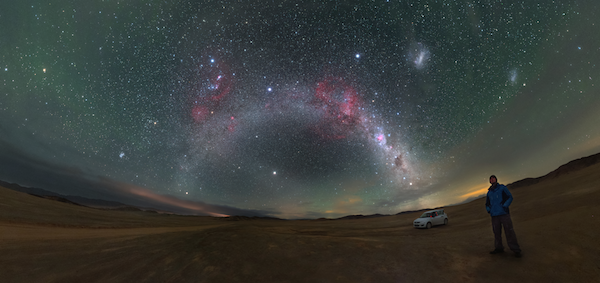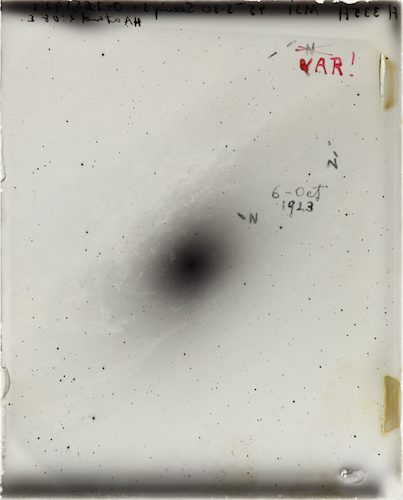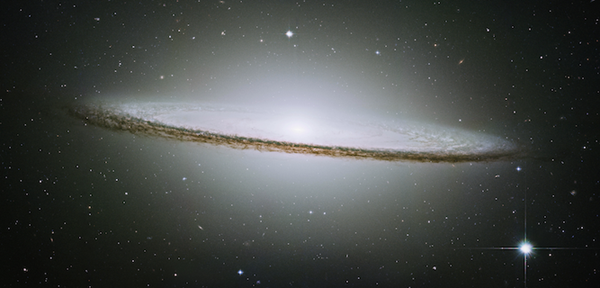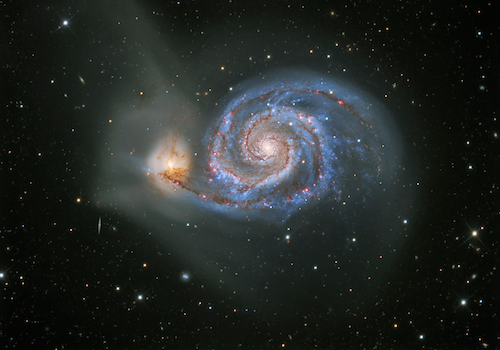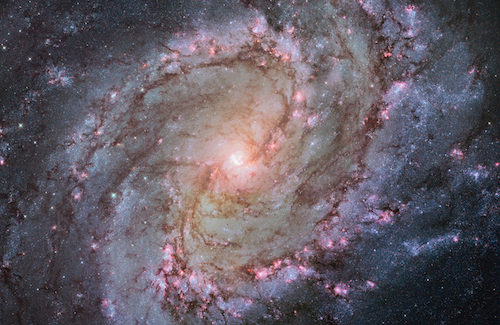Edwin Hubble was a fourth-year astronomer at Mount Wilson; he enjoyed using the Hooker Telescope because he was interested in, among other things, studying spiral “nebulae.” These mysterious gas clouds were scattered across the sky, and no one understood their nature. In the early days of the 1920s, Hubble had assigned himself the task of figuring them out.
He pointed the great telescope toward his favorite object: the nebula in Andromeda, M31. This spiral-shaped cloud is faintly visible to the naked eye under a clear, moonless sky. He then captured its image on a photographic plate. Hubble was excited by the result. On it, he found a suspected nova, an exploding star. The next night, he photographed M31 again, hoping to catch the nova and record it under better atmospheric stability. The second plate did indeed record the nova, but little did he know, he also had captured a plate that would become legendary in the history of science.
His observing time over, he returned to his office to analyze the catch. Suddenly, Hubble made an astonishing realization: The nova was not a nova at all, but a particular type of star that changed its brightness, a Cepheid variable. Checking earlier plates, he was able to confirm that, and he realized that the star’s faintness had incredible implications.
The star, and the nebula that encompassed it, must lie at a distance of a million light-years — three times larger than anyone at the time believed the size of the whole universe to be. Today, thanks to improved measurements, astronomers know the object is 2.5 million light-years away.
Aided in part by earlier work done by Vesto M. Slipher and by his own colleague Milton Humason, Hubble had at once discovered that the universe was far larger than anyone had believed, and that spiral nebulae like Andromeda were actually distant galaxies. They were whole systems of stars and gas, separated from our own Milky Way by a long hike.
By 1929, astronomers had put a cosmic picture of the past together. If you traced the histories of many of the galaxies backward in time, it meant that the cosmos began with a small, infinitely dense point at its origin. This research was an extension of work originally done by Belgian astronomer Georges Lemaître. Astronomers understood this cosmic point of origin, later called the Big Bang, as the start of the universe, and it must have occurred billions of years ago, they calculated. The Big Bang had commenced the expansion that was driving all the galaxies away from each other as time rolls on. The whole universe seemed to be flying apart.
In the 1930s, Hubble began to study and classify galaxies into their various so-called morphological types, the array of structures astronomers saw in photographs. He eventually assembled the types of galaxies he observed into a tuning fork-shaped diagram. It contained spiral galaxies, barred spiral galaxies — spirals containing a linear “bar” of material passing through their centers — lenticular (lens-shaped) galaxies, and elliptical galaxies. He also identified irregular galaxies, clouds of stars and gas that lacked an organized shape. Later on, astronomers identified peculiar galaxies, systems that appeared to be wracked with explosive or disruptive events. They also identified a class of galaxies called dwarf spheroidals, which seemed to be numerous in the local universe.
By the 1950s, French astronomer Gerard de Vaucouleurs of the University of Texas had expanded Hubble’s classification scheme into a more complex system that took into account many observed properties of galaxies. De Vaucouleurs produced a pseudo-three-dimensional plot showing the galaxies’ relationships, nicknamed the “Cosmic Lemon” due to its shape. De Vaucouleurs included details on bars in galaxies, descriptions of rings of matter visible in them, and an evaluation of how loosely or tightly the spiral arms of a galaxy were wound. He also included evaluative details about the nature of irregular and peculiar galaxies.
The last generation of extragalactic astronomy has moved into far more sophisticated analyses than cataloging. By using the Hubble Space Telescope, astronomers have estimated that some 100 billion galaxies must exist in the cosmos. And the number may be much greater than that. Probably some 2 trillion galaxies existed in the early universe, but it seems clear that galaxies near each other are drawn together by gravity and combine over cosmic time. Despite the universal expansion, then, normal galaxies like the Milky Way are probably made of dozens or more protogalaxies that merged into larger systems. You can see these primitive blobs of matter, bluish protogalaxies, in the early universe within the Hubble Ultra Deep Field pictures.
As astronomers have studied greater numbers of galaxies over the past few decades, they’ve discovered many things, but one that is impossible to ignore is that the universe is incredibly large. If you look at a galaxy in your telescope’s eyepiece tonight, the photons striking your eye have been traveling at the fastest speed there is — 186,000 miles per second (300,000 kilometers per second). Nonetheless, they have taken 2.5 million years at that velocity to reach us from the Andromeda Galaxy. And that object is nearly on our cosmic doorstep.
Of course, the knowledge of our own galaxy, in a primitive sense, goes back to antiquity. The name Milky Way comes from the Latin via lactea, which derives from the original idea, the Greek term, galaxías kýklos, “milky circle.” The band of Milky Way visible in our sky, most prominently in the summer and winter evenings, is the unresolved light from billions of stars lying along the plane of our galaxy.
But only in the past few decades have we come to understand that the Milky Way is one of the 100 billion galaxies in the universe, and that its disk stretches some 100,000 light-years across. It contains some 400 billion stars, although we don’t know exactly how many because dwarf stars are faint and difficult to see over long distances. For decades, astronomers believed the Milky Way was a simple spiral galaxy. But studies in this century have shown the Milky Way is a barred spiral, and that our Sun and solar system lie some 26,000 light-years from the center, in one of the galaxy’s arms.
The Milky Way consists of a bright disk, a slowly spinning platter of stars and gas that contains most of the stars we see. Our Sun orbits the center of the galaxy once every 220 million years, meaning that we’ve rotated around the galactic center about 20 times since the formation of the solar system. Far away, in the center of the galaxy, lies a supermassive black hole containing around 4.3 million times more mass than the Sun. In recent times astronomers have discovered that supermassive black holes in the centers of galaxies are the norm. Nearly all galaxies, except for dwarfs, have them.
The galaxy’s disk is encapsulated by a halo of a small number of stars, along with huge spheres of ancient stars called globular star clusters, and a big envelope of dark matter. Astronomers don’t yet know what dark matter consists of, but they know it is there because of the gravitational influence it has on the visible matter they can observe.
The Local Group
The Milky Way is hardly alone in the cosmos. It belongs to a group of at least 54 objects called the Local Group of galaxies, a name Hubble gave to this local cloud of objects as he mapped the nearby cosmos. The primary members of the Local Group are the Milky Way, the Andromeda Galaxy, and the Pinwheel Galaxy (M33). But each of these big three spirals has a cloud of attendant galaxies, too. The Milky Way’s satellites include the Large and Small Magellanic Clouds, visible to the naked eye in the Southern Hemisphere, and many dwarf galaxies. The diameter of the Local Group is about 10 million light-years, some 100 times the diameter of the Milky Way.
The Whirlpool Galaxy in Canes Venatici, another galaxy near the Big Dipper, is also known as M51 and is a top telescope target. An interacting pair of galaxies, the Whirlpool is being passed by a little interloper, NGC 5195, which is drawing material off one of the larger galaxy’s spiral arms. The pair lies 23 million light-years away, and M51’s disk stretches across 60,000 light-years.
The Virgo Cluster contains at least 1,500 galaxies and is centered some 54 million light-years from Earth. You can see some of the brightest galaxies near the core of the Virgo Cluster in amateur telescopes, in an array called Markarian’s Chain. This line of galaxies contains supermassive elliptical galaxies such as M49, M84, M86, M87, and others, and a variety of spiral galaxies, too. For backyard astronomers, this playground of galaxy types is one of the really entrancing areas of the sky, and it is best visible on springtime evenings under clear, moonless conditions.
Most of the Virgo Cluster galaxies contain supermassive black holes in their centers. M87 is quite an example. Whereas the Milky Way’s central black hole weighs in at 4.3 million solar masses, the colossal black hole inside M87 contains an estimated mass of 5 billion to 7 billion suns, some 1,000 times more massive than ours. M87 is one of the largest galaxies in our part of the universe — it is a so-called cD galaxy, short for centrally dominant, and it has “eaten” many of the smaller galaxies that once surrounded it. That’s what massive galaxies do — they consume their neighborhood partners.
Superclusters
A cluster containing 1,500 galaxies is one thing, but much larger assemblages of galaxies also exist. The Virgo Cluster itself is a member of the so-called Virgo Supercluster, or Local Supercluster, which holds thousands of galaxies on a scale an order of magnitude larger yet. The Virgo Supercluster holds our Milky Way, the Local Group, the Virgo Cluster, and altogether some 100 galaxy groups and clusters. This amazingly large framework stretches some 110 million light-years across, and it is one of about 10 million superclusters that make up the entire cosmos.
Despite the huge number of galaxies existing in the Virgo Supercluster, astronomers now know that most of the space in this volume is essentially empty, consisting of great voids. The diameters of these voids range from dozens to hundreds of millions of light-years. Filamentary chains of galaxies wind their way around the dark voids. On large scales, galaxies in clusters and superclusters are like soap bubbles, with galaxies coating the surfaces and voids lying in between.
By the end of the 1980s, astronomers had identified the Great Wall, a sheet of galaxies measuring 500 million light-years across. More recently, the Sloan Digital Sky Survey uncovered the Sloan Great Wall, an assemblage of galaxies at least twice the size of the Great Wall, which covers a long dimension of some 1.4 billion light-years.
The big picture
Additional surprising discoveries have occurred, too. In 2014, astronomers identified a new supercluster based on the relative motions of galaxies analyzed in a more sophisticated way than ever before. University of Hawaii astronomers concluded that the Laniakea Supercluster exists, and named it after the Hawaiian word for “immense heaven.”
Laniakea, which is also sometimes called the Local Supercluster, contains some 100,000 galaxies, including the Local Group and the Milky Way. This massive cluster and all its members are traveling together through space, but not all of the galaxies within it are gravitationally bound. Some will splinter apart from the rest of the cluster as time rolls on.
The Laniakea Supercluster has four major components — the Virgo Supercluster, the Hydra-Centaurus Supercluster, the Pavo-Indus Supercluster, and the Southern Supercluster. Altogether, Laniakea contains around 500 galaxy clusters and groups. And surrounding Laniakea in the local universe are other galaxy superclusters — the Shapley Supercluster, the Hercules Supercluster, the Coma Supercluster, and the Perseus-Pisces Supercluster. Each of these structures holds hundreds of galaxy clusters and are linked by the fabriclike web of cosmic structure.
And beginning in the 1980s, astronomers found evidence of structures even larger than superclusters. At first, objects now called Large Quasar Groups (LQG) baffled astronomers. In 1982, Scottish astronomer Adrian Webster found what would become known as the Webster Large Quasar Group, a collection of five quasars stretching over 330 million light-years. Now, nearly two dozen LQGs are known. A structure known as the Huge LQG contains 73 quasars over a diameter of some 4 billion light-years. This massive structure, dismissed by some astronomers, may hold the title as the largest collection of related matter in the cosmos.
Truly, the universe is so big that it’s hard to comprehend. On one hand, the enormity of the universe makes us feel small. Our brief lives happen so quickly, and we wink out, mostly unaware of the incredibly large cosmos around us. But the fact that we are sentient, that we can ponder the stars and galaxies far away from us, makes life in the universe a truly amazing thing. And we’re just starting to get to know the immense world of galaxies.

